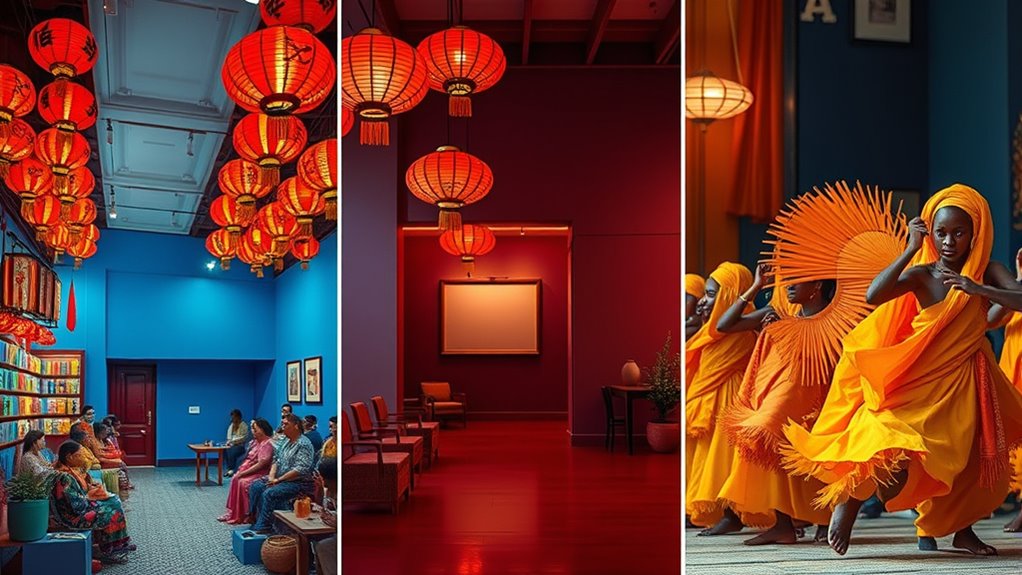You should understand that color meanings vary widely across cultures, influencing how messages are perceived. For example, white represents purity in Western cultures but symbolizes mourning in some Eastern societies. Red signifies luck and celebration in China but warns of danger in the West. Green can mean growth or spirituality but also jealousy, depending on the region. Recognizing these differences helps you communicate more effectively and avoid misunderstandings as you explore the fascinating world of cross-cultural color perception.
Key Takeaways
- Cultural associations heavily influence how different societies perceive and interpret colors.
- Color symbolism varies globally, affecting emotional responses and branding strategies across cultures.
- Misunderstanding cultural meanings of colors can lead to miscommunication or unintended offense.
- Regional differences in color meanings require tailored approaches in marketing, product design, and event planning.
- Awareness of cultural color perceptions enhances authentic engagement and fosters trust in international contexts.

Colors may seem universal, but how people perceive and interpret them varies widely across cultures. When you look at a bright red, it might evoke feelings of passion or danger in one culture, while in another, it symbolizes prosperity and good fortune. This is because color symbolism is deeply rooted in cultural associations that shape how individuals respond to different hues. These associations influence everything from marketing and design to personal choices and social interactions. Understanding this variation helps you avoid miscommunication and guarantees your messages resonate appropriately across diverse audiences.
In many Western cultures, white typically signifies purity, innocence, and cleanliness. You might see it on wedding dresses or in healthcare settings, reinforcing these cultural associations. However, if you travel to some Eastern cultures, white can represent mourning and death. This stark contrast highlights how cultural associations color your perceptions and reactions to the same shade. Recognizing these differences is essential when you’re working with international markets, designing products, or even planning multicultural events. It’s not just about choosing the right color but understanding what that color signifies within a specific cultural context.
Similarly, red carries varied meanings depending on where you are. In China, red is a symbol of luck, happiness, and celebration, often seen during festivals and weddings. Conversely, in some Western countries, red can signal danger or warning, such as stop signs or emergency alerts. These contrasting interpretations show how cultural associations influence the emotional impact of color. If you’re creating branding or advertising campaigns, knowing the cultural significance of red ensures your message aligns with local perceptions and avoids unintended negative connotations.
Green also demonstrates cultural diversity in symbolism. In many Western societies, green is associated with growth, health, and eco-friendliness. However, in some Middle Eastern cultures, green has religious significance, representing paradise and spirituality. In certain parts of Asia, it can symbolize fertility or vitality, but it may also be linked to jealousy or envy in others. Recognizing these cultural associations helps you communicate more effectively, especially when introducing new products or ideas across borders. Additionally, understanding regional color symbolism enhances your ability to craft culturally sensitive messages and designs.
Ultimately, understanding the nuances of color symbolism and cultural associations empowers you to connect authentically with diverse audiences. It reminds you that color perception isn’t just a matter of personal preference but a complex interplay of history, tradition, and societal values. When you pay attention to these cultural differences, you can craft messages, designs, and experiences that resonate more deeply, fostering trust and understanding in a globalized world.
Frequently Asked Questions
How Do Color Preferences Influence International Marketing Strategies?
Your color preferences shape your international marketing strategies by directly impacting brand identity and consumer behavior. You should select colors that resonate positively within each culture to attract attention and foster trust. By understanding cultural color meanings, you can tailor your branding to evoke the right emotions, encouraging consumers to engage and purchase. This strategic approach helps you build stronger connections and stand out in diverse markets.
Are There Universal Color Meanings Across All Cultures?
You’ll find that universal color meanings are rare because cultural color associations vary widely. While some colors like white for purity or red for danger may seem consistent, cross-cultural color symbolism often shifts based on context and country. Don’t assume a color’s message will translate seamlessly; instead, explore local perceptions. Recognizing these differences helps you craft culturally conscious campaigns that connect and communicate clearly across all cultural boundaries.
How Does Color Perception Impact Cross-Cultural Communication?
Color perception greatly impacts cross-cultural communication because you interpret color symbolism differently across cultures. You might see red as a sign of love or danger, but in some cultures, it symbolizes prosperity or mourning. By understanding these cultural symbols, you can avoid miscommunication and foster better connections. Recognizing the importance of cultural symbolism helps you navigate diverse contexts more effectively, ensuring your message resonates appropriately with different audiences.
Do Cultural Traditions Affect Color Symbolism in Art?
Yes, cultural traditions profoundly influence color symbolism in art. You’ll notice that cultural rituals often assign specific meanings to colors, shaping traditional symbolism. For example, red might symbolize luck in Chinese culture, while it represents mourning in some Western societies. These associations guide artists in choosing colors, reflecting cultural values and beliefs. Understanding these traditions helps you interpret art more deeply and appreciate its cultural significance.
Can Color Psychology Influence Intercultural Conflict Resolution?
You might think color psychology’s just about fashion, but it actually influences intercultural conflict resolution. By understanding color connotations and cultural symbolism, you can navigate sensitivities and foster empathy. Using the right colors can bridge divides or, ironically, deepen misunderstandings if misinterpreted. Recognizing these subtle cues helps you communicate more effectively, turning color’s emotional power into a tool for harmony rather than discord in diverse settings.
Conclusion
Remember, beauty is in the eye of the beholder. As you’ve seen, cultural backgrounds shape how you perceive colors, influencing emotions and behaviors. Don’t assume everyone interprets colors the same way; instead, embrace these differences as a way to deepen your understanding of others. By appreciating these variations, you can communicate more effectively across cultures and avoid misunderstandings. Ultimately, recognizing that perceptions vary reminds us that, in diversity, there’s strength.








